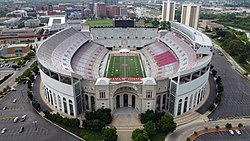
Back Ohio Stadium German Ohio Stadium Spanish ورزشگاه اوهایو Persian Ohio Stadium French オハイオ・スタジアム Japanese 오하이오 스타디움 Korean Ohio Stadium Polish Ohio Stadium Portuguese 俄亥俄体育场 Chinese
This article needs additional citations for verification. (August 2024) |
"The Horseshoe" "The Shoe" "The House That Harley Built" | |
 Ohio Stadium in June 2021 | |
| Address | 411 Woody Hayes Drive |
|---|---|
| Location | Columbus, Ohio |
| Coordinates | 40°0′6″N 83°1′11″W / 40.00167°N 83.01972°W |
| Owner | Ohio State University |
| Operator | Ohio State University Department of Athletics |
| Capacity | 102,780 (since 2019) |
| Record attendance | 110,045 (November 26, 2016 vs. Michigan) |
| Surface | Shaw Sports Momentum Pro (2022–present)[1] FieldTurf (2007–2022) AstroTurf (1971–1989) Grass (1922–1970, 1990–2006) |
| Construction | |
| Broke ground | August 3, 1921 |
| Opened | October 7, 1922 |
| Renovated | 2000–01 |
| Expanded | 1948, 1991, 2001, 2014 |
| Construction cost | US$1.34 million ($24.4 million in 2023 dollars[2]) |
| Architect | Howard Dwight Smith Class of 1907 |
| General contractor | E. H. Latham Company |
| Tenants | |
| Ohio State Buckeyes (NCAA) 1922–present Ohio Glory (WLAF) 1992 Columbus Crew (MLS) 1996–1998 | |
| Website | |
| ohiostatebuckeyes.com/ohio-stadium/ | |
Ohio Stadium | |
 Interactive map highlighting the stadium's location | |
| NRHP reference No. | 74001494 [3] |
| Added to NRHP | March 22, 1974 |
Ohio Stadium is an American football stadium in Columbus, Ohio, on the campus of Ohio State University. It primarily serves as the home venue of the Ohio State Buckeyes football team and is also the site for the university's Spring Commencement ceremonies each May. Common nicknames for the stadium include "The Horseshoe", "The Shoe", and "The House That Harley Built".
From 1996 to 1998, Ohio Stadium was the home venue for the Columbus Crew of Major League Soccer prior to the opening of Columbus Crew Stadium in 1999. The stadium also was the home venue for the OSU track and field teams from 1923 to 2001. In addition to athletics, Ohio Stadium is also a concert venue, with U2, Taylor Swift, The Rolling Stones, Genesis, Pink Floyd, and Metallica among the many acts to have played at the venue.
The stadium opened in 1922 as a replacement for Ohio Field and had a seating capacity of 66,210. In 1923, a cinder running track was added that was later upgraded to an all-weather track. Seating capacity gradually increased over the years and reached a total of 91,470 possible spectators in 1991. Beginning in 2000, the stadium was renovated and expanded in several phases, removing the track and adding additional seating, which raised the capacity to 101,568 by 2001 and to 102,329 in 2007. In 2014, additional seating was added in the end zone, raising the official capacity to 104,944. Another renovation to add more luxury suites began in 2017 and will eventually lead to a decrease of 2,600 seats. It is the largest stadium by capacity in the state of Ohio, and the third largest on-campus football stadium in the United States. Ohio Stadium was added to the National Register of Historic Places in 1974.[3]
- ^ "Ohio State University Safelite Field". Retrieved 2024-10-06.
- ^ 1634–1699: McCusker, J. J. (1997). How Much Is That in Real Money? A Historical Price Index for Use as a Deflator of Money Values in the Economy of the United States: Addenda et Corrigenda (PDF). American Antiquarian Society. 1700–1799: McCusker, J. J. (1992). How Much Is That in Real Money? A Historical Price Index for Use as a Deflator of Money Values in the Economy of the United States (PDF). American Antiquarian Society. 1800–present: Federal Reserve Bank of Minneapolis. "Consumer Price Index (estimate) 1800–". Retrieved February 29, 2024.
- ^ a b "National Register Information System". National Register of Historic Places. National Park Service. July 9, 2010.